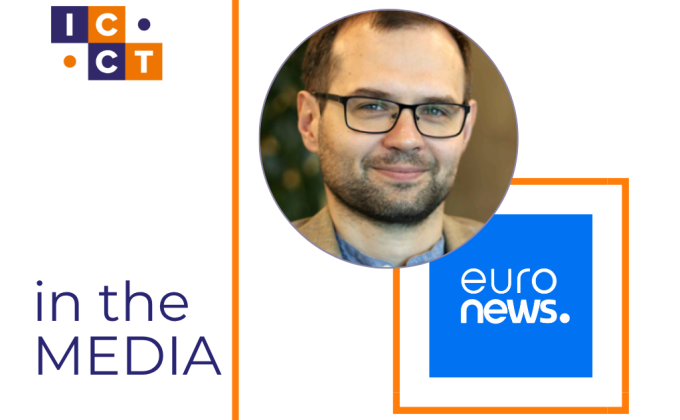On 15 September 2014, Hivos and the International Centre for Counter-Terrorism – The Hague (ICCT) co-hosted a seminar on the Islamic State in Iraq and Syria (IS). What are the causes of the groups strong uprising? What can be done to counter IS and what do to about foreign fighters who go to this region to fight among extremist groups? Panelists were Regional Expert Fidaa Itani (read his paper on al Qaeda’s role in Syria and Iraq here), Mariwan Kanie (Assistant Professor at the University of Amsterdam), Munir Zamir(Director of FIDA), Mark Singleton (ICCT Director), Tini van Goor (Programme Director, Hivos) and Kawa Hassan (Middle East Expert, Hivos). To explain IS's emergence and current power, one has to go back to the first stages of the Syrian revolution, in 2011. Revolutionary groups sought to ouster President Assad, install democracy and spur economic development. The failure to do so, in part caused by fundamental political dispute among the international county with regard to Syria, created a political vacuum which would be filled by various militant extremist groups. Feeding on the Syrian population's disenchantment, these groups provided a violent alternative to the secular opposition, whose role in the civil war has since been diminished. IS - in contrast to Al Qaida - offers not only an ideology, but has also proven to have the capabilities to govern a territory and its inhabitants, providing "governmental" services and imposing law and order in its self-declared Islamic State. To understand the conflict in the region in general and in Syria and Iraq in particular, the importance of going beyond sectarianism as the conceptual tool of analyses was stressed. The conflict is within and across the sectarian alliances. What is witnessed now, are radical forms of the localization of politics. What we are witnessing today are radical expressions of localized politics, related to tribal, ethnic, provincial and regional loyalties. Power struggles are happening at all levels simultaneously, each with its own regional and international dimensions. But what will be next for Syria and Iraq now IS is taking over more territory? And how should the international community respond? Four scenarios were discussed. Firstly, local armed groups will gradually lose the territory currently under their control to IS. Syria will effectively be split into parts ruled by the regime and parts ruled by IS/other extremist groups, with resource-rich areas remaining contested by the government and IS forces. In this scenario, the Syrian regime is likely to actively seek international assistance from the international community against IS. Secondly, a paradoxical “stability of civil war” will be reached, in which the conflict will continue and no political solution be found for the foreseeable future. IS will slightly expand or decline in its actions and control over people and territory – just what is needed at the time to avoid attacks by the regime or international forces. This means that the role of IS will change with its context. Thirdly, local forces achieve a victory. Iraq and Syria will likely support IS which will lead to IS operations in the West. Airstrikes will not do enough to counter IS: local groups are the only ones that can actually hit and effectively combat IS. This may take years, but in the long term this scenario would actually solve the issue and its causes. It was emphasised that regardless, the political issues in the region have to be addressed to effectively counter IS and related groups. The fourth and last scenario - airstrikes by an international coalition and ground attacks by empowered local fighters – plays on this idea: this option will not solve the causes of the existence and rise of IS, but will most likely lead to more local support for the group. As a part of this scenario, expansion of the conflict and extremist groups to Jordan and Lebanon is possible, if a political plan to balance the power in the region is not made. Overall, the outlook for resolving the current crises in Syria and Iraq, as well as the rise of IS was not an optimistic one. However, speakers also indicated that IS's strategy was not merely aimed towards the West; rather, attacking Western targets and allies - including Israel – were to trigger support and sympathy among its opponents in the Middle East. An important point touched upon by all speakers in this context, was the role of outside forces both in causing and countering the current situation in Syria and the region. The discussion also touched on the appeal IS and others have on foreigners. Why do European youth for example want to go to Syria or Iraq to fight? Here, the role of religion was discussed by speakers, including the ability of IS to represent a narrative that has partially long been part of Islamic writings. However, other incentives, such as a sense of belonging, duty and identity provided by extremist groups, were also mentioned, highlighting a need for governments in the West to do more to address these matters. This makes it easy for extremist groups, with the help of social media and recruiters, to appeal to foreigners to join their cause. Overall, governments need to consider how they can counter extremist narratives not only reactively, but proactively, including by providing a feeling of identity, duty and belonging, as well as by creating equality of opportunity and providing access. Here, lessons learned from the Arab Spring will be crucial. Halting the rise of IS in the region would not be achieved through airstrikes; on the contrary. A political solution that addresses the root causes is needed. Societies need to build resilience to counter the rise of extremist groups like IS. This necessitates a long-term strategy, with emphasis on regional politics and the role of civil society in strengthening local groups. A counter-narrative that offers youth a sense of identity and respect is urgently needed.
November 04, 2014



